A few weeks ago, I interviewed Tamara Buckley Johnson to find out how she was preparing to conquer The Coastal Challenge Rainforest Run, a six-day endurance event covering approximately 155 miles. (Read An Ultrarunning Mom Faces Costa Rica’s Coastal Challenge for background.) The 46-year-old from Pleasant Hill, California, survived severe heat, extreme nausea, fever, bugs, and blisters in Costa Rica’s jungles and mountains. After she had time to recover, I asked some follow-up questions about the experience. Here’s her report of mud, sweat, and fears.
Sarah: How did it go on the first day as you adjusted to the climate and the start of the run?
Tamara: Sunday morning (January 30), we arrived by bus to the start at 8:30 a.m. We were informed that the race would officially start at 10 a.m. It was a difficult 90 minutes for me, with the temperatures and humidity getting more intense by the minute. I felt hot and sweaty sitting in the shade not doing anything but sipping my water. It also gave me too much time to think about running in the heat, and I increasingly became more anxious. The race began at approximately 10 a.m.
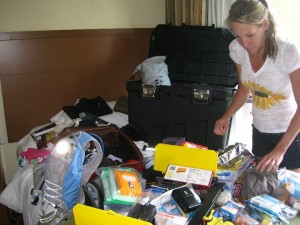
Tamara organizers her gear before the race starts. She and other participants kept all their belongings in a container called an "Action Packer," which the race directors transported between campsites.
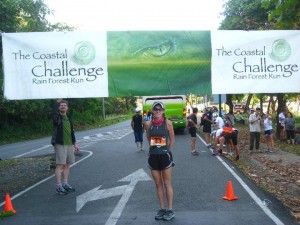
At the start: "The heat and humidity were unbearable, and all I could think about was, 'What the hell did I get myself into?'"
The first 8K was everything I worried about and worse. It was on black pavement, fully exposed to the sun, and without a doubt the most difficult 8K (5 miles) I have ever run. The heat and humidity were unbearable, and all I could think about was, “What the hell did I get myself into?” I started doubting myself and feeling very scared by my commitment of the next six days. It was then that two female runners came up next to me, Karen and Shannon, asking me where I was from, what type of running did I do, etc. It was just the distraction I needed. The next few hours I ran and talked to whoever would listen to me. It made a difference to know that I was not alone in my fears and concerns.
However, I was already struggling the first day with my energy level. The only way I could describe the heat is to compare it to sitting in a steam room at a gym and trying to run with a 5-pound pack on. My legs felt heavy, and my breathing was off from the start. At the finish of the first day I felt dehydrated, nauseous, and sunburned. My friend Kelly pointed me in the direction of the pool on the campgrounds. I took off my shoes and my pack and crawled into the cold water. I left the pool and immediately walked over to the massage tent. I had a one-hour massage, and the idea of running the next day did not seem so impossible.
I understand you got sick—what happened and how did you deal with it?
I may have had a lowered resistance at the very start, because symptoms of a cold and flu hit immediately. I had a horrible headache, fever, and chills after the first day of running and slept terribly the first night. I went out the second day with the plan to drop at an aid station if I needed, but I met up with some other runners, and it was apparent everyone was suffering to some degree so I joined them and ran it in. The third day was my most difficult—the climbing was relentless, and the heat was unbearable in stretches.
On the third day, I was approximately 5K from the finish, 9 hours into my run, when I lost site of the trail markers and got lost. I walked around for a while trying to backtrack and was fortunate to spot several other runners who were also looking for the trail markers. It was at that point that I just did not have it physically or mentally to continue.
One other runner was feeling worse than I was, so I stayed with her until we could get transported to the finish. I could not keep any food or liquid down for over 24 hours; I had no energy and felt extreme stomach pain. I’m not sure if it was a parasite or dehydration. I know for a fact that I was not properly heat trained for this event, and that I became dehydrated very quickly, most likely the first day. However, over half the camp was suffering with stomach issues and reported a stomach virus going around. Regardless of what or how, I was really sick. I tried to go out again after one day of rest but could not physically do it—I could not keep food and water in my system.
Emotionally at this point I was frustrated and feeling a bit like a loser. I made the best of it though and enjoyed the beach while I waited for the runners to come in.
What was a more typical 24-hour period during the event, if any were “typical”?
At 3:30 a.m. the alarm goes off. I grab my headlamp, look for my running clothes, which I typically would put next to my head the night before. Next, I would get dressed and begin the process of taking down the tent and packing up all the gear in the dark, wet morning. Getting all of my gear packed away into my Action Packer was always a challenge. Breakfast is served at 4 a.m. Eggs, rice and beans, bread, fresh fruit, coffee, and juice were standard. After breakfast I would fill my water in my pack, replace my salt and electrolytes tabs, and double check my food that I would need for the day’s run. I would apply sun block and bug repellent, and powder on my feet, before hauling my Action Packer over to the trucks, which would transport them to our next location. 5 a.m. the race starts. Depending on the course, it’s four to nine hours of running in the hot, humid rain forests.
The course varied greatly, with an incredible amount of elevation gain each day. Some days the course was ankle-deep, shoe-sucking, single-track mud trails; other days there was no trail at all and you were bushwhacking your way up the side of a mountain; and lastly, there were the hours of beach running in the direct sun.
After finishing the day’s race, it was time to locate your Action Packer and begin the process of setting up camp. At every campsite there were some sort of showers. Everyday at all times there were bugs and gnats everywhere, and they were especially attracted to you following the run when you were hot, sweaty, and smelly. The heat and humidity never let up; it was just always hot and sticky.
After the finish each day there was enough time to set up your tent, take a shower, get a massage, have your feet checked by the doctor, and hang out and talk with fellow runners before dinner at 5:30 to 6 p.m. Dinner was typically chicken and beef, beans, rice, pasta, salad, fruit, and a cake for dessert. 7:00 every night was the pre-race meeting, providing the details for the next morning’s run. Most of the runners were in their tents and attempting to sleep by 8 p.m.
Generally speaking, what were the best and worst parts of the experience for you?
I learned a lot about learning to cope physically and emotionally with being in a constant state of discomfort, but I was extremely hot, sweating, and nauseous for a good portion of the six days. I had two huge blisters on my feet, bug bites all over my ankles and lower legs, and it seemed like everything was wet all the time and smelled bad. The first night of rain, I forgot to shut my Action Packer and woke up to my friend Kelly saying, “Tamara you left your Action Packer open all night and everything is wet.” The second night it rained really hard, and I did not put the fly on my tent correctly. My tent was leaking water at my head and at my feet. This was also the night I was vomiting and had horrible stomach issues.
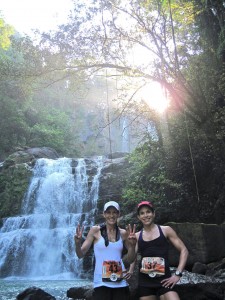
Tamara with Karen Hasty. "The very best part of the experience by far was the people I met along the way." (Photo courtesy Karen L. Hasty)
The beauty of it all is that you get through it and learn to really appreciate feeling good and not being uncomfortable. It reminds me of one of my favorite quotes: “You’ll never know how strong you are … until being strong is the only choice you have.”
But the very best part of the experience by far was the people I met along the way. There is something about forming a trauma bond with someone that instantly turns a stranger into a friend. I have many new friends from all over the world, and I look forward to running, laughing, crying, and playing with them again!
Did the experience change you as a person and as a runner, and if so, how?
I now have a new understanding of what it means to “dig deep,” and I have the utmost respect for multi-day stage races and stage runners. It is by far one of the most difficult, challenging running events I have attempted to do. The physical and mental demands far exceed that of any 100-mile race or running experience I have had.
I have come to know for myself that you can never be too confident or too prepared for an event like this because anything can and does happen regardless of how experienced or knowledgeable you think you are. There is no room for egos out on the rainforest trails of Costa Rica. I am humbled and in awe of every one of the runners that started and finished this race.
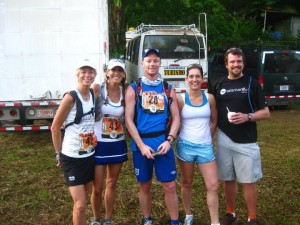
Tamara, second from left, with friend Kelly Ridgway on the far left, Martin Nobbs and Gillian Reid from England in the middle, and Erik Lindstrom of TCC Adventures.
Would you do it again?
Wow, that is like asking a woman during labor if she wants to have another baby. 🙂 I definitely will sign up and attempt to start and finish another stage race. I will train differently and go into it with a tad bit more knowledge than when I started this one.
Congratulations, Tamara—you are brave!
Note: TCC Adventures, organizer of The Coastal Challenge, reported that the event had a 60 percent finisher’s rate for the full course, which is in line with previous years. “It’s just damn tough,” says their Facebook status report.
For another report on the experience, check out the blog post by Tamara’s friend Kelly Ridgway. “Damn tough” is putting it mildly!

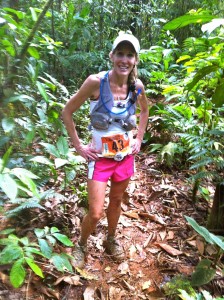
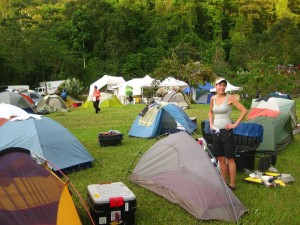
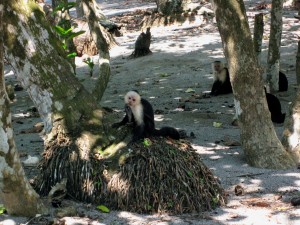
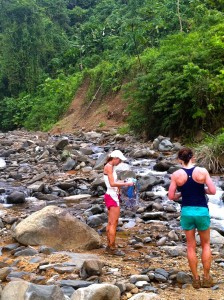
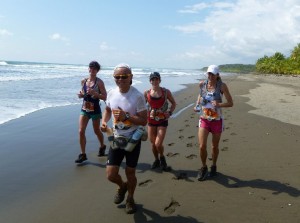
Hi Tammi,
I am so proud of you and your accomplishments. I can’t wait to hear the stories and see all your pictures.
Love you,
Gee